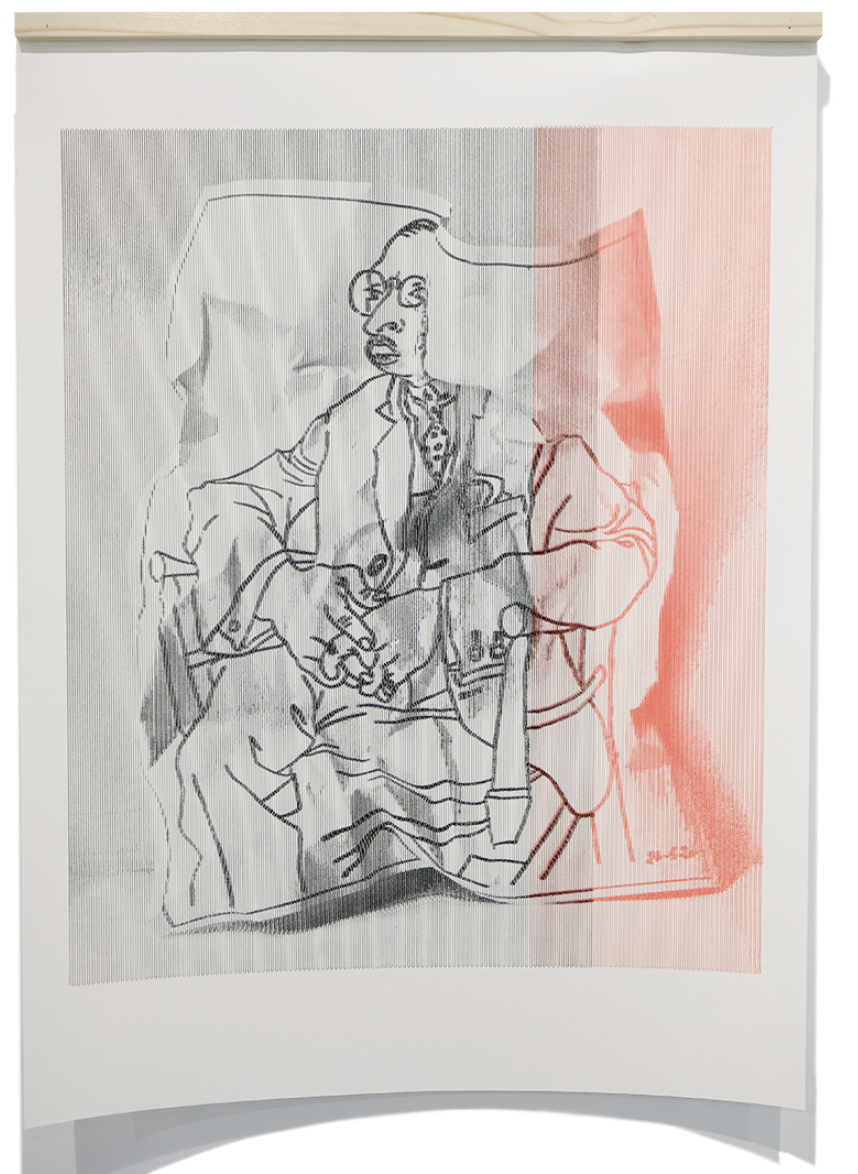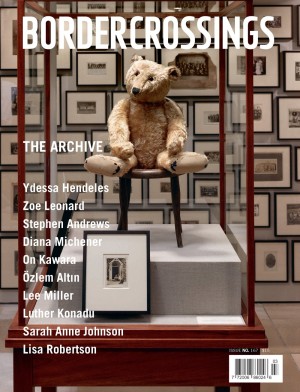Bramwell Enan and Matthis Grunsky
Bramwell Enan and Matthis Grunsky are Winnipeg-based artists whose practices focus on invention in the areas of process and materiality. The works in this exhibition, mainly from the past year, present a dialogue between Enan’s sculptural work and Grunsky’s two-dimensional works.
Bramwell Enan uses a plethora of materials that combine found and mass-produced objects with craft and process. Stone, yarn, latex, cork, plastic and iron, and processes including painting, stone cutting, forging and digital printing, come together in Enan’s practice, along with their interest in ornamentation, architecture, prose and poetry. Installing their work on walls, near the ceiling, in corners and behind pillars, creates an element of surprise for viewers. Many of Enan’s works incorporate found pieces of Tyndall stone. It’s evident the artist enjoys the architectural reference inherent in the material, and, in some works, arranges the stones on the wall with small, sand-filled balloons interacting with them, creating an uncanny and whimsical dialogue. In the piece there are no pure cultures; the wars we wage are all civil wars, vertical bars of stone, each capped with a small, sand-filled balloon, are placed at equidistant intervals alongside three sticks wrapped in brightly coloured, handmade paper clay strips. There is a lyrical quality to the rhythm of the work as you move from left to right, connecting this work to another wall piece titled The Bedrock of Song. This work presents several right-angled bars of stone, punctuated by the same colourful balloons. Enan’s sculptures incorporate largely abstract elements, although the shapes, titles and materials suggest metaphorical associations.

Bramwell Enan, The Bedrock of Song, 2025, Tyndall stone, latex balloon, sand, 41.91 × 58.42 × 3.18 centimetres. Photo: Bramwell Enan. Courtesy the artist.
A diptych, The truth emerged, only to turn into another dream and vanish, presents two identical pieces of Tyndall stone on the wall. Enan had the same intricate pattern cut into both stones. The one on the left appears to be a beautiful piece of ornamentation. A small purple balloon sits on top of it, seemingly privileging its higher aesthetic standing. The piece on the right is flipped to reveal its reverse side, exposing a collapsed version of the pattern and a darker coloration. In presenting these two objects, Enan encourages exploration of their differences.
Two pieces, human in scale, are woven from wide strips made from paint and modelling paste over cork. The strips, in luscious tones of purple, green, burnt umber and terracotta, are arranged in a loose criss-cross pattern. Suggesting a human presence, at the top of each piece is a small balloon and a 3-D printed plastic miniature chasuble. Given the chasuble’s role as priestly ornamentation, these pieces allude to glorification and adornment or, conversely, restriction and control.
Matthis Grunsky, a conceptual artist, is concerned with ideas of authorship. He employs computer technology in his practice, based on writing code. Grunsky’s works are created by the artist’s programming a plotter that uses a ballpoint pen to draw according to his coded instructions. The drawings take hours to produce. During this time he responds to what is being produced and often makes alterations. The works in this exhibition represent his first explorations using photographs as the source material, resulting in complex works. Grunsky regards his works as three-dimensional objects, and, to that end, has devised an elegant hanging mechanism to hold them away from the wall.

Matthis Grunsky, strav. jpg, 2025, plotter drawing, 63.5 × 86.36 centimetres. Photo: Matthis Grunsky. Courtesy the artist.
The five 22” x 30” works in Channel Plots are sourced from photographs on the artist’s phone, each transformed by the plotter into disparate drawings. These works represent pattern as it appears in daily life, by chance or by design. The human and technological processes used in creating these images speak directly to the complexities of authorship.
A series of four small, square works on paper, Grid Drops, presents a central, computer-drawn blue grid, which becomes a counterpoint for black ink splotches. The ink has been dropped onto the paper from a height of almost two metres, with resulting shapes and ever-sofine lines appearing throughout the paper’s surface as traces of the process. In these works, both computer and artist interact to create a whimsical interplay between two methods of drawing, although neither involves the artist’s hand contacting the paper.
Due to its foundational relationship to Grunsky’s conceptual practice, Upside Down is presented at the front of the gallery. The work is comprised of a plaster square with a repeating pattern of black loops. It was created by pressing an embossed paper napkin into wet plaster, resulting in a linear design the artist made visible using a black sharpie. Upside Down is a commentary on the ubiquity of generic design permeating everyday life.

Installation view, “Soft (paths),” 2025, 226 Main, Winnipeg. Photo: Matthis Grunsky. Courtesy the artists.
A diptych of acrylic paintings on canvas titled Homage to Homage references Josef Albers’s mid-20thcentury series of the same name. Grunsky cleverly updates Albers’s use of oil paint by writing code that has generated infinite numbers of colour combinations from which to choose. The composition is rotated 90 degrees from Albers’s, and his two paintings fittingly mirror each other. In a triptych, strav.jpg, he used a reproduction of Picasso’s drawing of Igor Stravinsky, routinely used as a teaching tool for drawing. Grunsky, a university drawing instructor, asked his students to respond to the drawing and, after class, found the reproduction crumpled and abandoned. The artist’s photograph of the discarded drawing was then used as the basis for this work. Three iterations of the same image are presented using the colours black, red and blue. Each is a continuation of the one before it as it begins with the last colour used in the previous work, revealing the process of creation. ❚
“Soft(paths)” was exhibited at 226 Main, Winnipeg, from January 31, 2025, to February 11, 2025.
Leesa Streifler is a visual artist based in Winnipeg. She is Professor Emerita in visual arts at the University of Regina. A touring retrospective of her work, “Leesa Streifler: The Performance of Being,” is currently at Nickle Galleries, Calgary, until April 26, 2025.

